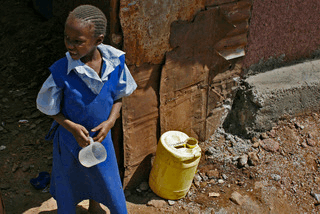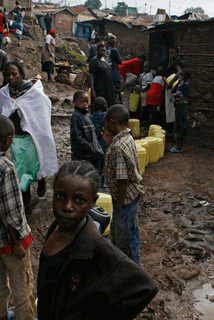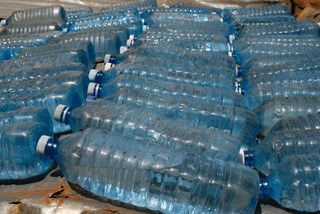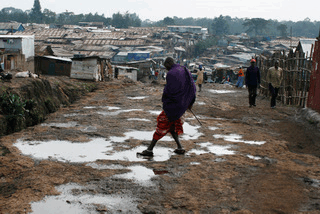Clean Water for Kenya
Air Date: Week of August 14, 2009

Kibera resident with empty cup and jerry-can for collecting water. A 20 liter jerry-can costs about five cents to fill. The average family uses between five and seven of these per day. (Photo: Alex Stonehill)
In Kibera, a slum of Nairobi, Kenya, clean water is too scarce. But a new technology that takes just a plastic bottle and six hours in the sun is helping reduce sickness and diarrhea in the community, and in other developing countries around the world. Jessica Partnow reports.
Transcript
GELLERMAN: It’s an encore edition of Living on Earth. I’m Bruce Gellerman. Kibera, in Nairobi, Kenya, is one of the world's largest slums. It's home to about a million people, and many grinding social problems - violence, poverty, unemployment.
But perhaps the biggest threat to Kibera's residents is the lack of sanitation and clean water. Shortages and contamination have brought diseases and death to the people in the Kenyan slum. But residents are fighting back with a simple, low-cost solution, as Jessica Partnow now reports.
[SCHOOLYARD WITH KIDS PLAYING]
PARTNOW: At the Stara Primary School in Kibera, students play in the shadow of a towering water tank. Their footsteps kick up clouds of red dust, which hang in the humid air. Mary Muthini, who's better known as Teacher Mary, runs the school.
MUTHINI: This school was started in the year 1999 with around six children, who were orphans. Initially we started a feeding program, but then the vision of educating them came into our mind and we thought of, as much as we feed them, we should also be educating them.

Kibera residents stand in line to buy water from a vendor. Because of interruption in the water supply, lines can sometimes be hours long. (Photo: Alex Stonehill)
Nariobi's water reaches the outer edge of the Kibera settlement. From there, water flows through a network of low quality PVC pipes into the 25 hundred-gallon water tanks that dot the streets.
Much of the water supply is controlled by private vendors, who charge Kibera residents over ten times more than high-income residents of Nairobi, and sometimes create artificial water shortages.
And that's for water that isn't always clean. The pipes break frequently, exposing the water to sewage.
Again, Teacher Mary.
MUTHINI: We had so many cases of waterborne diseases. Such like typhoid, cholera, dysentery, just to mention but a few.
PARTNOW: In 2007 the UN Development Program reported that six in ten infants in Kibera die of waterborne diseases before the age of 18 months.
For residents surviving on less than a dollar a day, paying for fuel for boiling or for chlorine tablets, on top of the price for the water itself, is out of reach.
[STREAM FLOWING, MUSIC, KIDS]
PARTNOW: At a riverbank behind the school sit piles of garbage alongside tin houses and tangled barbed wire. The river here doubles as an open sewer.
[OUTDOOR SOUNDS, BABY CRYING, LAUGHTER]
PARTNOW: Thirty year old Habiba Mohamed grew up in Kibera. A black headscarf frames her face. And a flash of gold sparkles from a front tooth as she speaks.
MOHAMED: You see, a toilet facility like this one can be used by more or less a thousand people because...
PARTNOW: She points to an outhouse shared by a thousand people and says rather than stand in line, many residents prefer to use a Flying Toilet. Also known as a plastic bag.
MOHAMED: Like here you can find most of the garbage here – if you had the guts to look – most of it is feces.
PARTNOW: Mohamed works for the internationally funded Kenya Water for Health Organization. She goes door to door trying to convince her neighbors to treat their drinking water using Solar Water Disinfection, also known as SODIS. It's a low-tech approach to cleaning water.
OTIENO: So, this is one way of treating water - drinking water - at the household level, using UV light.
PARTNOW: That's Joseph Otieno, Kenya Water for Health's SODIS project officer. He says all you need is a clear soft plastic bottle.
OTIENO: So you, the first time you get this bottle you clean it. Then you fill it with water, then you close it tightly. Then you expose the bottle to the sun for a minimum of six hours.

Plastic bottles filled with water and placed on corrugated metal in the sun are a common site in the Makina area of Kibera. (Photo: Alex Stonehill)
SODIS was developed in Switzerland and is now used by two million people in Latin America, Africa and Asia. Test after test has shown SODIS produces sanitized water that easily meets World Health Organization guidelines.
OTIENO: We always test our water so that we can assure the community that the water is clean, it is safe, for drinking.
PARTNOW: Some find it hard to believe that SODIS actually works. Habiba Mohamed says she's even had doors slammed in her face.
MOHAMED: Yeah it happens! You come they say "Ah, they are coming!" whoof! They bang the door. They refuse if from the first day and that remains. And I wish they would refuse it and have an alternative. But they refuse it arrogantly: "I've been taking this water for the past 50 years. Who are you to change me now?"
PARTNOW: But Kenya Water for Health reports that 250,000 Kibera residents are now using SODIS. There has been a 20% decrease in diarrhea cases since the program’s inception in 2004, and a shrinking need for costly hospital visits.
Teacher Mary saw an immediate change in the health of her students.
MUTHINI: When SODIS came in, we actually observed a high reduction of the waterborne diseases. That is we had no more complaints, no more pupils coming to complain about waterborne diseases any more.
STUDENTS: SODIS, OH SODIS. Safe water. It is easy to make. Just get a bottle, plus the sun! And your water will be treated. SODIS! How wonderful it is!
PARTNOW: Teacher Mary's students know all about SODIS. The idea is that children will encourage their parents to use the solar bottles, as well as use them themselves.
But while it's clear SODIS is making a difference, Habiba Mohamed is quick to point out that it's not a perfect solution.

A Masai man washes his sandals in puddles from the previous night's rainstorm. It’s estimated that 60 percent of Nairobi's residents live in slums like Kibera on the city's outskirts. (Photo: Alex Stonehill)
MOHAMED: Just as long as they don't take the water like it is. Because we now understand that we've a bit tried to take people from taking raw water, to make sure they take a step of improving their water. Because water is life, at the same time water is death.
STUDENTS: Water is important in our life. We need water to drink, cook and so on. Remember: good health depends on clean water. And that is SODIS. How wonderful it is!
PARTNOW: For Living on Earth, I'm Jessica Partnow in Kibera, Kenya.
STUDENTS: …from waterborne diseases like cholera…
[STUDENTS CONTINUE CHANTING; CLAPPING]
GELLERMAN: Our report on Kibera's drinking water was funded by the Pulitzer Center on Crisis Reporting. For more information about the project, check out our website - loe.org.
Links
Living on Earth wants to hear from you!
Living on Earth
62 Calef Highway, Suite 212
Lee, NH 03861
Telephone: 617-287-4121
E-mail: comments@loe.org
Newsletter [Click here]
Donate to Living on Earth!
Living on Earth is an independent media program and relies entirely on contributions from listeners and institutions supporting public service. Please donate now to preserve an independent environmental voice.
NewsletterLiving on Earth offers a weekly delivery of the show's rundown to your mailbox. Sign up for our newsletter today!
 Sailors For The Sea: Be the change you want to sea.
Sailors For The Sea: Be the change you want to sea.
 The Grantham Foundation for the Protection of the Environment: Committed to protecting and improving the health of the global environment.
The Grantham Foundation for the Protection of the Environment: Committed to protecting and improving the health of the global environment.
 Contribute to Living on Earth and receive, as our gift to you, an archival print of one of Mark Seth Lender's extraordinary wildlife photographs. Follow the link to see Mark's current collection of photographs.
Contribute to Living on Earth and receive, as our gift to you, an archival print of one of Mark Seth Lender's extraordinary wildlife photographs. Follow the link to see Mark's current collection of photographs.
 Buy a signed copy of Mark Seth Lender's book Smeagull the Seagull & support Living on Earth
Buy a signed copy of Mark Seth Lender's book Smeagull the Seagull & support Living on Earth

